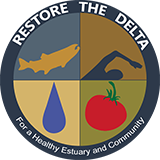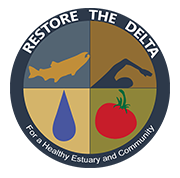With all eyes and ears in California water fixated on the State Water Resources Control Board’s proposed updates to the Water Quality Control Plan for the Bay-Delta, Delta stakeholders from all sides have offered their opinions on how to manage San Joaquin River inflow in recent weeks.
Fish biologist Dr. Peter Moyle shares five articles from the June 2018 issue of the North American Journal of Fisheries Management (NAJFM) in a recent post on the California Water Blog, titled, “Science, the Delta, and the future of San Joaquin salmon,” and concludes with his interpretation of what these studies could mean.
Policy Analyst for Restore the Delta, Tim Stroshane critiqued Dr. Moyle’s interpretations, explaining that,
“In the last few paragraphs of his most recent blog, Dr. Moyle highlights a 2010-2015 study of salmon passage through the Delta in the San Joaquin River. The study found that most of the surviving salmon were those salvaged (collected and trucked downstream) at the south Delta pumps near Tracy and Byron. These six years included just two relatively wet years and four consecutive dry years. Dr. Moyle does not break down the salvage numbers by year; without having seen the study is it possible that most of the salvage occurred from 2012-2015, the four driest years of the period involved? Instead of breaking this out, Dr. Moyle takes the scientist-authors’ conclusions to mean that “survival of salmon in the south and central Delta is extremely low (from the San Joaquin side). ‘This in turn implies,’ he says, ‘that massive habitat restoration is required to improve [salmon] survival. Without improving habitat, just increasing flows through the region is unlikely to have much effect on salmon survival.’
“Two things: One, no one on the environmental water side ever argues that flows should be increased AND that habitat restoration is unneeded. We do say that flow is itself habitat and a necessary component of restoration implementation.
“Second, Dr. Moyle fails to break out the salvage numbers from the various years to give readers a more fine-grained sense of how salmon in the San Joaquin actually did in those six years (most of which were low flow years).
“These were hard years for the Delta (2012-2015) and the rest of California. How certain can we be that Dr. Moyle has accurately presented the implications of the study when it is behind a paywall at the North American Journal for Fisheries Management to judge for ourselves?

